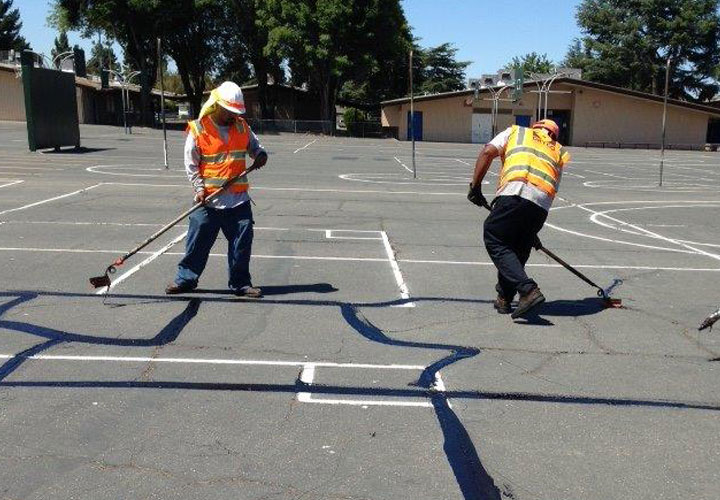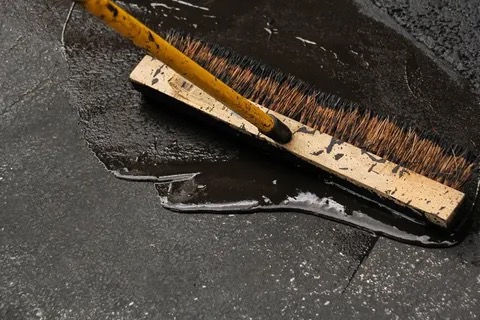Enhance Sturdiness: Warm Mix Asphalt Sealing for Angled Parking Structures
Enhance Sturdiness: Warm Mix Asphalt Sealing for Angled Parking Structures
Blog Article
Hot Mix Asphalt: A Lasting Option for Sidewalk
Warm Mix Asphalt (HMA) has actually arised as a leading lasting selection for pavement remedies, supplying a myriad of environmental advantages and ingenious modern technologies. As the demand for eco-friendly building techniques expands, exploring the nuances of HMA's sustainability can provide important insights into the future of pavement solutions.
Environmental Advantages of Hot Mix Asphalt

Furthermore, Warm Mix Asphalt assists to alleviate metropolitan warm island impacts. Its dark shade takes in sunlight, reducing the amount of warm reflected back into the atmosphere compared to lighter-colored sidewalks. This can lower ambient temperature levels in city areas, decreasing the demand for a/c and ultimately minimizing power usage.
In addition, Hot Mix Asphalt contributes to boosted stormwater management. Its permeable nature enables water to penetrate the pavement and recharge groundwater materials, decreasing overflow and the threat of flooding. These environmental benefits make Hot Mix Asphalt a lasting option for paving roadways and highways.
Power Efficiency in HMA Manufacturing
Is energy efficiency an important factor in the production of Hot Mix Asphalt (HMA)? Energy plays a considerable duty in the production of HMA, affecting both cost and ecological sustainability. One essential facet of power efficiency in HMA manufacturing is the use of warm mix asphalt (WMA) technologies.
In addition, developments in plant innovations have actually led to even more energy-efficient HMA production processes. By enhancing energy usage in HMA manufacturing, the market can decrease its carbon impact while maintaining high-grade sidewalk materials.
Recyclability of Warm Mix Asphalt
The recyclability of Warm Mix Asphalt (HMA) is a crucial element of its sustainability and long-lasting environmental influence. HMA is among the most recycled products in the United States, with over 100 million lots of redeemed asphalt sidewalk (RAP) being recycled annually in new pavement building and construction. Recycling HMA offers numerous ecological benefits, such as decreasing the requirement for virgin products, reducing energy intake throughout manufacturing, and reducing the amount of waste sent out to land fills.
The procedure of recycling HMA includes crushing the existing pavement, squashing it into smaller items, and mixing it with brand-new aggregate and asphalt binder to create a recycled mix. This recycled mix can typically carry out along with or perhaps better than standard HMA, while needing fewer resources and producing reduced greenhouse gas emissions. By integrating RAP right into brand-new sidewalk projects, road agencies can preserve natural deposits, reduce costs, and lessen the ecological impact of roadway building and construction and upkeep activities. Generally, the recyclability of HMA plays a significant duty in promoting lasting practices within the sidewalk industry.

Long-Term Performance of HMA
Asphalt sidewalks demonstrate toughness and durability over a prolonged duration, reflecting the lasting performance of Warm Mix Asphalt (HMA) The long life of HMA can be connected to its ability to stand up to heavy website traffic tons, severe weather, and the impacts of aging. Research studies have actually revealed that well-designed and appropriately created HMA pavements can last for two decades or even more with normal maintenance. The trick to maximizing the lasting efficiency of HMA exists in utilizing top quality materials, complying with ideal practices in building, and executing effective upkeep methods. Appropriate water drainage, routine examinations, and timely repair services are essential for maintaining the architectural stability of HMA sidewalks gradually. In addition, advancements in HMA technology, such as making use of polymer-modified binders and cozy mix asphalt, have further improved the toughness and durability of HMA pavements. By focusing on quality building and maintenance techniques, HMA remains to verify itself as a cost-effective and sustainable option for lasting sidewalk facilities.

HMA: Sturdiness and Sustainability
Showing both sturdiness and sustainability, Hot Mix Asphalt (HMA) has become a keystone in the building and construction of resilient pavement facilities - hot mix asphalt. HMA's longevity comes from its ability to stand up to heavy lots, extreme climate condition, and high website traffic volumes, making it a dependable choice for roads, freeways, like it and airport terminal runways. The make-up of HMA, which usually consists of accumulations, binder, and filler, plays an important duty in improving its longevity and resistance to put on and tear
In addition, HMA's sustainability lies in its recyclability and energy-efficient manufacturing process. The capability to recycle reclaimed asphalt sidewalk (RAP) in new HMA mixes decreases the need for virgin products and lessens the ecological effect of sidewalk building and maintenance. In addition, the power performance of producing HMA exists in its lower mixing temperatures compared to other pavement products, resulting in reduced energy usage and greenhouse gas discharges.
Conclusion
Finally, warm mix asphalt (HMA) supplies a lasting option for sidewalk with its ecologically friendly qualities. HMA's recyclability, energy effectiveness in production, and long-lasting toughness make it a green choice for roadway building and construction. By saving natural resources, minimizing waste, and lowering greenhouse gas discharges, HMA plays an essential function in promoting sustainability in framework development. Its ability to reduce city heat island results better highlights its relevance in producing environmentally mindful and resilient pavement systems.
HMA is one of the most recycled materials in the United States, with over 100 million tons of redeemed asphalt sidewalk (RAP) being recycled each year in new sidewalk building.The procedure of recycling HMA entails grating the existing pavement, squashing it into browse this site smaller pieces, and mixing it with brand-new accumulation and asphalt binder to develop a recycled mix.Asphalt pavements show toughness and resilience over a prolonged period, mirroring the long-lasting efficiency of Warm Mix Asphalt (HMA) In addition, advancements in HMA modern technology, such as the usage of polymer-modified binders and cozy useful source mix asphalt, have better boosted the durability and long life of HMA sidewalks. The capacity to recycle reclaimed asphalt sidewalk (RAP) in new HMA blends decreases the need for virgin materials and reduces the ecological influence of pavement building and upkeep.
Report this page